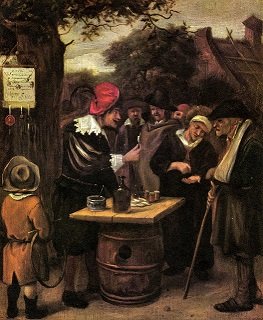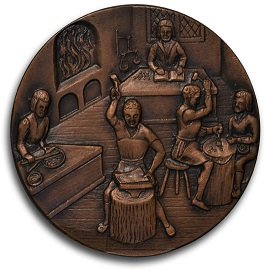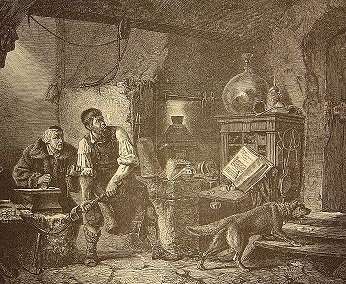William Chaloner, Master Counterfeiter
William Chaloner was born in Warwickshire sometime around the late 1650s. His father was a weaver, but William showed little aptitude for the trade and was reportedly a wilful child, so his parents sent him away to Birmingham to be apprenticed to a nail maker. William had little interest in making nails, but he showed an aptitude for another form of metalwork that Birmingham had become notorious for – the production of counterfeit groats. The groat was an odd coin, being worth at various times in history either fourpence, eightpence or being interchangeable with the shilling. The design was usually crude, and the metal was heavily adulterated silver. This made it a perfect target for the entirely non-silver versions produced by the less than ethical craftsmen of Birmingham.

In the 1680s William, like so many others, walked to London to attempt to find work. Unfortunately for him the restrictive system of Guilds in the capital had the legitimate metalworking trade locked down, and so he was forced to find alternative employment. This took the shape of producing articles that respectable tradesmen would not – specifically, according to a biographer shortly after his death, “tin watches with dildos in them.” [1] His patter in selling these unusual devices revealed a talent for “tongue pudding”, the verbal agility of the con artist. Soon he was working as a quack doctor and psychic, selling fake miracle cures, telling fortunes and locating stolen goods. Of course, just as with Jonathan Wild a century later, he was able to recover the goods due to contacts with the men who stole them. This led to his first encounter with the law, as a suspect in a burglary. He was forced to flee his lodgings, abandoning (permanently) his wife and children.
His next job was as a “japanner”, a trade that (like the dildos) originated in Italy. Imported Asian lacquerwork had seized the public imagination, and while the genuine article was prohibitively expensive, a cheap imitation was easy enough to do. The technique used by the japanners was little more than applying a thick coat of reflective lacquer (usually black) to furniture or tableware, the latter usually cheap tin or papier-mache articles. Decorative gilding was also often applied to the furniture, and it’s highly probable that William learned this technique as well. But japanning was not a highly paid job, and soon enough William fell back onto his earlier experience in Birmingham and became a counterfeiter.

This was not a light step to take. At the time counterfeiting money was considered treason, and thus punishable with hanging. Woman coiners fared even worse, as they were subjected to being burned at the stake. [2] Despite this, however, London had a large number of coiners at the time – the British coinage was in a terrible state, having only just introduced milled edges to prevent clipping. Worse, since some of the coins were worth less than their materials, they were subject to “deflationary arbitrage” – the practice of melting the coins to sell them for the metal. A quirk in the economics of the time meant that silver was worth more as bullion on the continent than it was in coins in Britain, leading to a shortfall in the coins in circulation. William joined a counterfeiting gang, and his talent soon began to shine. He started out creating French pistoles, but soon graduated to gilded guineas. He was successful enough to become wealthy, buying a house in the Surrey countryside where the noise of his coining machines would go unnoticed, though he had a few close calls with the law. In one case the man passing coins for him was arrested and revealed the details of his operation, though William was able to flee to Scotland until the unfortunate accomplice was hanged.
In 1693 William began to branch out into more ambitious scams, taking advantage of the wide scale paranoia in the British government over the recently dispossessed Stuart dynasty. His first scheme was to pay four Jacobite sympathisers to print copies of James II’s recent declaration denouncing King William. When the men arrived with the copies of the declaration he had commissioned, William had the police waiting. The men were executed, and William pocketed a £1000 reward. He and Aubrey Price, a protégé of his, then tried to convince the authorities that the Jacobites planned to attack Dover Castle and offered to infiltrate the fictitious plot. When this was rejected they then provided a fake list of Jacobite sympathisers, and managed to get themselves employed to investigate them. This proved a route to relative respectability for William, as it gave him many contacts in the government. His last foray into anti-Jacobite scams nearly proved fatal however. When he and a crooked thief taker named Coppinger co-wrote a Jacobite satire with the plan of using it to ensnare another printer with Jacobite sympathies, Coppinger tried to secure thefull reward for himself by denouncing William for coining and having him sent to Newgate. William was able to talk his way out of it, however, and even had Coppinger hanged for writing the satire.

In 1694 William decided to try to turn his coining business legitimate, and began circulating pamphlets denouncing the state of the Mint and offering to take over control of it, with various suggestion to prevent forgery (drawn from his own experience). His cause was taken up by the Earl of Monmouth, who had recently lost the post of Lord of the Treasury, as a means of attacking his successor. Unfortunately for William his proposal prompted a reform of the Mint by the man who had replaced Monmouth, the Earl of Halifax, which remedied many of the issues he had raised. Even more unfortunately for him, his actions placed him firmly in the cross-hairs of the man Halifax brought in to take the post of Warden of the Mint, Sir Isaac Newton.
Unaware that his Nemesis had been set on his trail, William turned his attention to an innovation that was ripe for his attention – paper money. The Bank of England had begun printing £100 bills on special distinctively patterned paper, but William was able to find his own source of paper and begin printing his own bills. These were eventually traced back to him through the source of the paper, but no laws had actually been passed to make forging bank notes illegal so he escaped punishment. In fact, he even managed to keep the profits from his forgery, and a £200 reward besides, when he took the opportunity to denounce his former associate Aubrey Price as a forger of cheques. Even though the technique Price used had been devised by William himself, he was hanged while William was celebrated.

William had managed to evade punishment for his crimes through a willingness to sacrifice any other coiners to secure his own freedom, which made certain authorities see him as a valuable informant. Newton, however, had decided that this most notorious forger would have to be brought to justice in order to return any semblance of respectability to the Mint. From his appointment in 1696 he began building up a case against William, recruiting an army of informants and researching deeply into William’s background. Every time William had been arrested was used by Newton as an opportunity to see more deeply into his world, and to find those who would have no compunction in testifying against the man so willing to turn on his former comrades. Finally, when William was arrested in October 1699 on a comparatively minor charge of lottery fraud, Newton struck. He had William committed for trial on counterfeiting charges, and arranged for the judge to be the notoriously severe Sir Salathiel Lovell.
At the time the structure of trials severely favoured the prosecution, and Newton took full advantage of this. He had two charges of counterfeiting brought against William, either of which would have been enough to see him hang. One was of his producing fake coins the previous year, and the second was for forging French pistoles, the first coins William had made in London. Newton had a full slate of witnesses, often the wives of the men that William had betrayed and sent to the gallows. They testified to his crimes and his skill, and the verdict of guilty was never in doubt.

William sought to avoid his fate by feigning madness but as the reality of his situation set in, his mental state seems to have suffered a genuine collapse. He wrote letters to Newton and the magistrates that were a mixture of wheedling and threatening, while in court he denounced all the witnesses as liars and frauds. After sentence was passed he continued writing his letters, though he never received a reply. On the morning of his execution, March 22nd 1699, he at first refused to see the priest sent to give him the sacraments, still protesting his innocence. Even as he was taken to the scaffold he addressed the crowd, declaring himself “murdered under pretence of Law”. The executioner was unmoved, and soon enough William Chaloner was no more. It was left to the journalists of the day and the historians down the years to wonder what a man of such ingenuity might have been able to accomplish if he had not drifted into the easy, but perilous, path of crime.
Images via wikimedia except where stated.
[1] Dildos had been available in England since at least the time of Shakespeare but had increased in availability over the previous decade, mostly in the form of Italian imports. A popular ballad of the day, Signor Dildo, drew a link between this and the arrival of Mary of Modena, the Italian wife of King James II.
[2] The standard punishment for woman guilty of all kinds of treason under British law at the time, including “petty treason”, or the murder of their husbands. A cord was attached to the woman’s neck to allow the executioner to “mercifully” strangle her as the flames reached her, though the cord would often burn through before he could do so.
